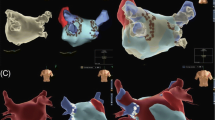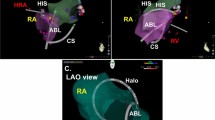Abstract
Cryoballoon (CB) is an established technology for atrial fibrillation (AF) ablation and is usually performed using solely fluoroscopy. We aimed to study the feasibility of three-dimensional rotational angiography (3DRA) as intra-procedural imaging in CB ablation. Analyzed data were retrospectively collected from patients that underwent second generation CB ablation from February 2015 to August 2017. We studied 68 consecutive patients that received 3DRA (3DRA group). Sixty-six patients who received conventional X-ray imaging served as a control group. 3DRA was performed via an introducer placed in the left atrium. Angiographic images were segmented and fused with live fluoroscopy to guide the ablation. We have analyzed 134 CB patients (73.8% male, 56.9 ± 11.4 years). Paroxysmal AF was present in 77.6% of patients. 3DRA was successfully performed in all 3DRA group patients. The mean procedure time was significantly shorter in the control group (82.4 ± 26.3 min) than in the 3DRA group (121.1 ± 21.4 min) (p < 0.0001). Total radiation dose (419.3 ± 317.9 vs 998.3 ± 673 mGy, p < 0.0001) and contrast administration (83.2 ± 22.3 mL vs 191.6 ± 33.4 mL, p < 0.0001) were significantly lower in control group. There was no significant difference in 2-year success rate, 35.2% of patients had AF recurrence in the 3DRA group and 30.3% in the control group (p = 0.584). Major complications occurred in 2.9% and 1.5% of patients in 3DRA group and control group, respectively (p = 1.000). 3DRA is a feasible method of intra-procedural imaging to guide CB ablation. However, it prolongs procedure time, increases radiation dose and contrast administration with no significant effect on procedure outcomes and complication rates.




Similar content being viewed by others
Data Availability
No associated data.
References
Calkins H, Hindricks G, Cappato R et al (2018) 2017 HRS/EHRA/ECAS/APHRS/SOLAECE expert consensus statement on catheter and surgical ablation of atrial fibrillation. Europace 20(1):1–160
Velagić V, de Asmundis C, Mugnai G et al (2017) Learning curve using the second-generation cryoballoon ablation. J Cardiovasc Med (Hagerstown) 18(7):518–527
Bollmann A, Ueberham L, Schuler E et al (2018) Cardiac tamponade in catheter ablation of atrial fibrillation: german-wide analysis of 21 141 procedures in the Helios atrial fibrillation ablation registry (SAFER). Europace 20(12):1944–1951
Donal E, Lip GY, Galderisi M et al (2016) EACVI/EHRA expert consensus document on the role of multi-modality imaging for the evaluation of patients with atrial fibrillation. Eur Heart J Cardiovasc Imag 17(4):355–83
Sticherling C, Marin F, Birnie D et al (2015) Antithrombotic management in patients undergoing electrophysiological procedures: a european heart rhythm association (EHRA) position document endorsed by the ESC working group thrombosis, heart rhythm society (HRS), and asia pacific heart rhythm society (APHRS). Europace 17(8):1197–214
Orlov MV (2009) How to perform and interpret rotational angiography in the electrophysiology laboratory. Heart Rhythm 6(12):1830–6
Ciconte G, Mugnai G, Sieira J et al (2015) On the quest for the best freeze: predictors of late pulmonary vein reconnections after second-generation cryoballoon ablation. Circ Arrhythm Electrophysiol 8(6):1359–65
Ghosh J, Singarayar S, Kabunga P, McGuire MA (2015) Subclavian vein pacing and venous pressure waveform measurement for phrenic nerve monitoring during cryoballoon ablation of atrial fibrillation. Europace 17:884–890
Fynn SP, Kalman JM (2004) Pulmonary veins: anatomy, electrophysiology, tachycardia, and fibrillation. Pacing Clin Electrophysiol 27(11):1547–59
Martinek M, Nesser HJ, Aichinger J, Boehm G, Purerfellner H (2007) Impact of integration of multislice computed tomography imaging into three-dimensional electroanatomic mapping on clinical outcomes, safety, and efficacy using radiofrequency ablation for atrial fibrillation. Pacing Clin Electrophysiol 30(10):1215–23
Malchano ZJ, Neuzil P, Cury RC et al (2006) Integration of cardiac CT/MR imaging with three-dimensional electroanatomical mapping to guide catheter manipulation in the left atrium: implications for catheter ablation of atrial fibrillation. J Cardiovasc Electrophysiol 17(11):1221–9
Jan M, Žižek D, Kuhelj D et al (2020) Combined use of electro-anatomic mapping system and intracardiac echocardiography to achieve zero-fluoroscopy catheter ablation for treatment of paroxysmal atrial fibrillation: a single centre experience. Int J Cardiovasc Imag 36(3):415–422
Goya M, Frame D, Gache L, Ichishima Y, Tayar DO, Goldstein L, Lee SHY (2020) The use of intracardiac echocardiography catheters in endocardial ablation of cardiac arrhythmia: Meta-analysis of efficiency, effectiveness, and safety outcomes. J Cardiovasc Electrophysiol. 31(3):664–673
Irfan G, de Asmundis C, Mugnai G et al (2016) One-year follow-up after second-generation cryoballoon ablation for atrial fibrillation in a large cohort of patients: a single-centre experience. Europace 18(7):987–93
Kowalewski CAB, Rodrigo M, Brodt C, Haddad F, Wang PJ, Narayan SM (2020) Novel three-dimensional imaging approach for cryoballoon navigation and confirmation of pulmonary vein occlusion. Pacing Clin Electrophysiol 43(3):269–277
Bourier F, Vlachos K, Lam A et al (2019) Three-dimensional image integration guidance for cryoballoon pulmonary vein isolation procedures. J Cardiovasc Electrophysiol 30(12):2790–2796
Maalouf J, Whiteside HL, Pillai A et al (2019) Reduction of radiation and contrast agent exposure in a cryoballoon ablation procedure with integration of electromagnetic mapping and intracardiac echocardiography: a single center experience. J Interv Card Electrophysiol. https://doi.org/10.1007/s10840-019-00667-z
Orlov MV, Hoffmeister P, Chaudhry GM et al (2007) Three-dimensional rotational angiography of the left atrium and esophagus–A virtual computed tomography scan in the electrophysiology lab? Heart Rhythm 4(1):37–43
De Potter T, Bardhaj G, Viggiano A, Morrice K, Geelen P (2014) Three-dimensional rotational angiography as a periprocedural imaging tool in atrial fibrillation ablation. Arrhythm Electrophysiol Rev 3(3):173–6
Fujita S, Fujii E, Kagawa Y, Inoue K, Yamada T, Ito M (2018) The seamless integration of three-dimensional rotational angiography images into electroanatomical mapping systems to guide catheter ablation of atrial fibrillation. Heart Vessels 33(11):1373–1380
Koektuerk B, Yorgun H, Koektuerk O et al (2016) Rotational angiography based three-dimensional left atrial reconstruction: a new approach for transseptal puncture. Cardiovasc Ther 34(1):49–56
Wolf J, Starek Z, Jez J et al (2015) Rotational angiography of left ventricle to guide ventricular tachycardia ablation. Int J Cardiovasc Imaging 5:899–904
Carpen M, Matkins J, Syros G, Gorev MV, Alikhani Z, Wylie JV, Natan SR (2013) First experience of 3D rotational angiography fusion with NavX electroanatomical mapping to guide catheter ablation of atrial fibrillation. Heart Rhythm 10(3):422–7
Knecht S, Wright M, Akrivakis S et al (2010) Prospective randomized comparison between the conventional electroanatomical system and three-dimensional rotational angiography during catheter ablation for atrial fibrillation. Heart Rhythm 7(4):459–65
Anand R, Gorev MV, Poghosyan H et al (2016) Prospective randomized comparison of rotational angiography with three-dimensional reconstruction and computed tomography merged with electro-anatomical mapping: a two center atrial fibrillation ablation study. J Interv Card Electrophysiol 46(2):71–9
Sagone A, Iacopino S, Pieragnoli P et al (2019) Cryoballoon ablation of atrial fibrillation is effectively feasible without previous imaging of pulmonary vein anatomy: insights from the 1STOP project. J Interv Card Electrophysiol 55(3):267–275
Funding
No funding was received.
Author information
Authors and Affiliations
Contributions
VV and MG were responsible for conception of the study and drafting of the manuscript. DK, PV, PI, IP and PM were responsible for acquisition and analysis of the data. JS, MC, DP and DM were responsible for critical revision of the manuscript and important intellectual content.
Corresponding author
Ethics declarations
Conflict of interest
VV received educational Grants by St Jude Medical, travel Grants and lecture fees from Medtronic and Biosense-Webster. MC received lecture fees from Medtronic. MP received educational and travel Grants from Medtronic and Biosense-Webster.
Ethics approval
Ethical approval was waived by the local Ethics Committee of University Hospital Centre Zagreb in view of the retrospective nature of the study and all the procedures being performed were part of the routine care.
Additional information
Publisher's Note
Springer Nature remains neutral with regard to jurisdictional claims in published maps and institutional affiliations.
Rights and permissions
About this article
Cite this article
Velagic, V., Mugnai, G., Kardum, D. et al. Intra-procedural three-dimensional rotational angiography in cryoballoon ablation for atrial fibrillation. Int J Cardiovasc Imaging 37, 389–397 (2021). https://doi.org/10.1007/s10554-020-02029-7
Received:
Accepted:
Published:
Issue Date:
DOI: https://doi.org/10.1007/s10554-020-02029-7




